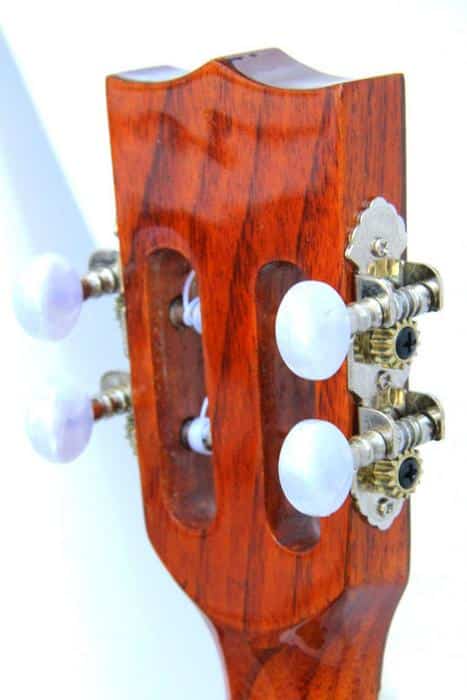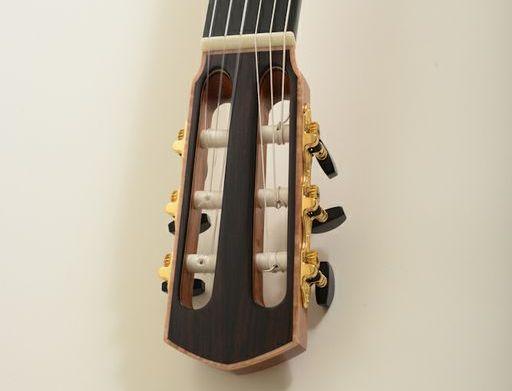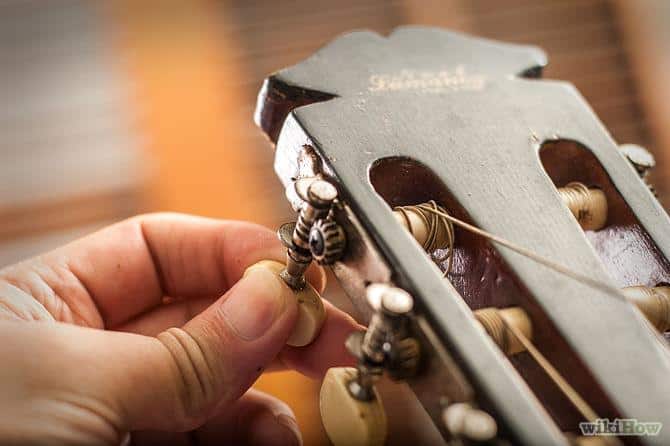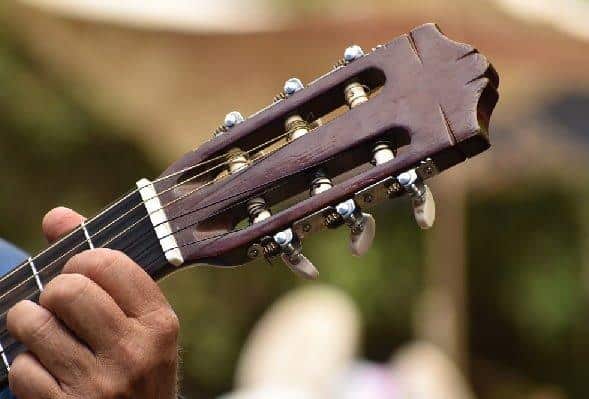My very first encounter with the burstingly beautiful universe of the ‘classical guitar headstock’ rewrote my understanding of this elegant instrument’s anatomy. It wasn’t 1995 anymore when I began my professional journey in lutherie; rather, I was embarking on a timeless odyssey of tradition, artistry, and innovation that would forever shape my career.
I’ve spent nearly three decades amassing a wealth of knowledge on the classical guitar headstock—its intricate design, the detailed process of its construction, and the subtle techniques of its repair—and it’s a thrill to be able to share these insights with you now. Surprisingly, this seemingly unassuming component of the guitar often goes overlooked in discussions about the instrument. And yet, it is a central element to the character and functionality of the whole.
Expect the unexpected as we delve into the diverse universe of the guitar headstock, a world bountiful in aesthetic variations and rich in technical possibilities. It’s an essential aspect of the classical guitar that plays a clutch role when it comes to superior sound and playability. And now, let’s strike a chord and tune into the alluring ballad of the classical guitar headstock.
Understanding Classical Guitar Headstock Design
Specifics of Slotted Headstock

Delving deeper into the world of classical guitar headstock design, it’s impossible not to address the specifics of the slotted headstock. The role this particular design plays in the acoustics and overall functioning of the guitar is more integral than many may realize. Reflecting on my experience, throughout my research-oriented approach to instrument construction, understanding the slotted headstock has played a crucial role.
The slotted headstock has long been a feature of the traditional guitar headstock design and has largely shaped the classical guitar we see and admire today. It not only lends to the instrument’s unique aesthetic appeal but also allows the strings to maintain a straight path from the nut to the tuning pegs. This contributes to the response and resonance of the instrument as a whole, producing the unique tonal qualities that set classical guitars apart.
A key distinctive element of the slotted headstock derives from its structural design. Notably, it carries a considerable depth compared to its width and length, thereby increasing the structural integrity and strength of the headstock. The inclusion of slots assists in reducing the overall weight and balances the headstock with the neck. The end result of this specific construction typically leads to improved resonance and sustain for the player.
Finally, the choice of material is crucial in the construction of a slotted headstock. Oftentimes, harder woods like mahogany or ebony are favored for their ability to withstand tension and contribute to overall resonance. The slotted design also poses challenges in woodworking, requiring a higher level of precision and craftsmanship than some other headstock designs, providing an additional testament to the intricacies of this iconic classical guitar element.
As we move forward to explore additional aspects of the classical guitar headstock, such as aesthetics and specific construction angles, the role of the slotted headstock as an integral component in guitar design becomes increasingly clear. Its influence and impact are as resonating as the strings it smoothly guides over its deep and well-cut openings. Embracing this understanding is another step in our exciting voyage of unraveling enigmas around guitar construction and repair.
Headstock Aesthetics and Unique Designs

Delving into the realm of headstock aesthetics and distinctive designs, we grasp a beautiful fusion of art and functionality that embellishes the classical guitar. My work with the Savart Journal and camaraderie with several luthiers has gifted me an exquisite palette of unique guitar headstock configurations, each oozing aesthetic charm and eminence.
Headstock design is not just about the visual appeal; it plays a vital part in the structure, balance, and overall sound quality of a guitar. Anchoring the strings and housing the tuning machines, the headstock’s design significantly influences the instrument’s performance. The uniqueness in each design usually signifies this underlying functionality making the guitar truly one of a kind.
From traditional open-scroll, slotted designs, to the unconventional fan, halo, or wing shapes, the diversity in headstock aesthetics is broad and awe-inspiring. Each design is a testament to the luthier’s ideation and craftsmanship, echoing their individual interpretations of the traditional forms.
In the headstock’s expression, we often find a luthier’s trademark or branding. Exquisite inlay work, artist signatures, distinctive slotted patterns, or even the tuning machine configurations add to the individuality of the headstock aesthetics, making each guitar unique in its own right. Through my collaborations, I’ve discovered that these aspects are not just for showmanship, but they tremendously impact the balance, weight distribution and sonic characteristics of the guitar.
One constant realization through my experience has been that aesthetics and performance are intertwined in headstock design. A unique guitar headstock enhances not just the visual appeal, but impacts the resonance, sustain, and overall sound production of an instrument.
As we further explore the classical guitar headstock angles and construction in the following sections, the relevance of aesthetics and design evolves beyond just visual appeal. This interplay resonates through the stringing methodology, tuning peg function, and even during repairs, reinforcing that every unique design inevitably contributes to the guitar’s sonic charm and playability.
Classical Guitar Headstock Angles and Construction

After years of crafting classical guitars and delving into the details behind their construction, one topic that never ceases to fascinate me is the design and angle of the classical guitar headstock. I’ve found that these seemingly secondary aspects hold remarkable importance, subtly but effectively informing the overall performance and playability of the instrument.
Angles and construction are crucial elements of a guitar’s design. But how do they impact your playing experience? The answer lies in the tension distribution and sustain, which heavily influence the tone and resonance of the music that you create. The headstock plays an instrumental role in successfully achieving these key qualities of sound.
If viewed through my engineering lens, the classical guitar headstock functions like a fulcrum, balancing the tension between the nylon strings and the guitar body. The headstock angle, or the degree at which the headstock inclines from the straight line of the neck, has a tremendous effect on this tension distribution, making the angle selection an art within itself.
Further refining this, the guitar nut angle complements the headstock angle in a dance of precision and balance. A well-angled nut, where the strings pass as they spread towards the tuners, aids in maintaining optimal string pressure against the fretboard. This contributes to consistent note clarity and suppresses undesirable buzz or rattle.
This relationship between the classical guitar headstock and the guitar nut angle requires that I apply not just my skills with tools and wood, but also my knowledge of physics and acoustics. Headstock angle choices thus reflect a maker’s expertise, forming a synthesis of craftsmanship and science.
When constructing a classical guitar, the headstock’s design matters just as much as its angles. A well-built classical guitar headstock ensures durability and longevity – it must withstand years of string tension without warping or failing. My choices of wood, adhesives, and reinforcement materials for the headstock construction go hand in hand with the design and angle considerations, providing the guitar’s structural and sonic strengths.
Moreover, the mechanics of classical guitar construction extend to the nylon strings headstock slots, affecting how the strings wind around the tuning pegs. Attention to this detail secures the strings, facilitates smoother tuning, and prevents string slippage – all contributing to a more pleasant playing experience.
In retrospect, such intricate interactions between angles, materials, and construction nuances may seem overwhelming. But, it’s my belief that understanding these relationships is what brings us closer to our instruments. Through this understanding, we not only grasp our instrument’s mechanics but also start appreciating the philosophy of its creation and the storytelling behind its music.
As we move forward to other aspects of the guitar headstock, remember that angles and construction play important roles – they are the backstage crew; unnoticeable from the front stage but working tirelessly behind the scenes for a flawless performance.
Stringing Methodology and Tuning Peg Function

In my many years as a luthier, I’ve developed a refined understanding and deep appreciation of the roles that stringing methodology and the proper functioning of tuning pegs contribute to the harmonic balance of a classical guitar. The world of classical guitar tuners and the delicate process of stringing a classical guitar are intricatley linked, both crucially affecting the sound that emanates from the instrument, and yet are often overlooked, underappreciated, and misunderstood by many.
Believe it or not, the way you string your guitar and how its tuning pegs function can drastically affect your sound. When stringing a classical guitar, it’s not just a matter of threading nylon strings onto the headstock. There’s an actual technique involved. The nylon strings should preferably be wound onto the tuning peg from the inner hole towards the outer edge. This helps to spread the tension across the peg evenly, preventing any unnecessary strain and potential slipping.
As it settles in, the nylon material of the strings stretches naturally and causes a drop in tension, which in turn affects the stability of the pitch. This is where your understanding of the tuning pegs comes into play.
The tuning pegs are the unsung heroes of a classical guitar’s functionality. Adjustments in their function allow for subtle changes in pitch, which can create different moods in your music.
Strict attention should be placed on ensuring that the tuners are snug and align perfectly with the headstock holes. The tuning peg shouldn’t wiggle inside the hole; if it does, the string’s tension may fluctuate unpredictably, leading to inconsistent sound quality. The friction between the peg and the hole plays a significant role, too. A well-functioning tuning peg should rotate smoothly, allowing for precise tuning.
I can still recall that one time, while restringing an antique lute for a client, I noticed that the tuning pegs did not fit seamlessly into the headstock – the pegs constantly slipped, causing my attempts at tuning to go in vain repeatedly. It was one of those moments that truly solidified my understanding of the critical role tuning pegs play in maintaining a guitar’s tune.
An incorrect methodology in stringing or a malfunctioning tuning peg can distort an intended melody, pushing it off-tune and killing the inherent beauty of a musical piece. But when these elements are expertly handled and harmonizing in symphony, the classical guitar can shine with its full potential.
So don’t be shy to spend that extra time perfecting your stringing process or maintaining the function of your tuning pegs. These are not just steps in a process but rather significant acts of care that ensure your instrument sings with its best voice. Emphasize the methodology of stringing, understand the key role of the tuning pegs, and bring your classical guitar to life.
Over the course of our exploration of the classical guitar headstock, we have unraveled the intricate design considerations, the specifics of slotted headstocks, and the art of aesthetic designing. Now, with the deep dive into stringing methodology and tuning peg function, we have added another essential layer to our understanding. Soon, we shall turn our attention to headstock repair methods, adding yet another dimension to our overall knowledge.
Classical Guitar Headstock Repair Methods

Delving into the realm of headstock repair, I’ve always found delight in the sheer satisfaction of renewing a damaged guitar back to its previous glory. In the span of my career, I’ve picked up a variety of techniques for repairing classical guitar headstocks – it is a skill every luthier must master. However, I believe that anyone possessing a passion for the instrument and a willingness to learn can grasp these guitar repair techniques.
Firstly, I advise on careful assessment of the damage. This initial step is crucial as it determines the path to be taken. Is the damage a minor chip, a crack, or a complete break? Each scenario necessitates a different approach.
For minor chips or surface cracks, using cyanoacrylate glue can be an effective solution. However, the application demands precision. Too much can create excess that is difficult to remove, and too little may not hold. After application, ensure clamping is done right, maintaining as much of the guitar’s original shape as possible.
Broken or damaged headstock? Don’t despair, I’ll share some insider tips on repairing classical guitar headstocks. Trust me, it isn’t as daunting as you might perceive. If you’re dealing with a clean break, where the headstock is completely separated from the neck, this is not necessarily a disaster. In fact, it’s often easier to repair than a crack because you have a ‘perfect’ fit to glue back together.
For severe headstock breaks it’s essential to clean up the break area before gluing. This involves removing the old glue, smoothing rough areas, and checking for missing wood. After cleaning, apply a generous amount of woodworking glue to both surfaces, press them together firmly and clamp. Remember to wipe away any excess glue that oozes out. The process of drying can take a couple of days, and only after can you start working on the headstock again.
Post-repair, there’s an indelible trace, a testament to the scar that once was. I find this a tangible reminder of resilience the instrument carries.
During repair, the structural integrity of the headstock should always be a priority. Spending time on getting to understand the intricacies ensures that you embrace the entire process of the guitar headstock repair, consequently prolonging the life of the guitar.
To further restore the aesthetic aspect after a break, you might opt for a veneer overlay. While this isn’t strictly necessary for functionality, I’ve found that it can offer a clean finishing touch, reviving the original elegance of your classical guitar.
In summary, classical guitar headstock repair requires a combination of technical knowledge, practical skills, and perhaps most of all, patience. It’s a delicate, intricate process – one wherein I’ve found immense gratification in seeing a beautiful instrument restored to its original condition, ready to create music once more. The journey of restoration itself is like a melody, filled with nuances and crescendos.
Having tackled repair techniques, we move on to comparing different types of headstocks, underlining the distinctive characteristics and intricate designs that make each headstock unique, yet intriguingly interconnected. Knowledge of this diversity, along with the repair skills you’ve just learned, offers a comprehensive, albeit fascinating, insight into the realm of the classical guitar headstock.
Comparing Different Types of Headstocks

As we delve deeper into the complexities of guitar headstock design, an engaging comparison awaits us. Just as the world of music is populated by diverse styles and genres, so too are the designs of guitar headstocks. It’s a fascinating journey across distinctive frameworks of classic, flamenco and acoustic guitars, with every unique guitar headstock offering its own narrative. So, let’s compare the headstocks of classic, flamenco, and acoustic guitars – you’ll be surprised at what you find.
In my years as an editor for the Savart Journal, I’ve observed fascinating differences, often nuanced but striking, among various types of guitar headstocks. The classical guitar headstock, crafted meticulously for centuries, tends to be slotted and typically accommodates three pairs of tuning pegs. The flamenco headstock, on the other hand, is usually also slotted but tends to be slightly lighter and less bulky than classical counterparts, reflecting the swift and sparkling nature of flamenco music.
By comparison, the acoustic guitar headstock often differs significantly. Many acoustic guitar designs favor a solid “paddle” headstock. This form factor generally accommodates six tuning pegs in a single row, ideal for quick tuning and adjustments mid-performance. The simplicity of its design, however, should not be mistaken for a lack of elegance or functionality. Ultimately, these diverse headstock designs are born from purpose, tradition, and the aesthetic conviction of their creators.
Each headstock has noteworthy features. The intricacies of the classical guitar headstock, which boasts Greek and Roman architectural influences, the flamenco headstock’s free-spirited flair, and the streamlined efficiency of the acoustic guitar headstock all demonstrate how form follows function in instrument design.
It’s also important to consider the impact that materials, thickness, angle, and construction methodology can have on the guitar’s overall sound production and playing comfort. It’s a rich tapestry of thoughtful craftsmanship, woven into every strum and pluck of a guitar string.
But as much as objective factors and craftsmanship matter, there is room for personal preference too. I’ve seen flamenco players who enthusiastically prefer the heftier classical guitar headstock, and classical purists who can’t resist the practical charm of the acoustic guitar headstock. And let’s not forget the countless variations within each genre, which allow guitarists to find a unique guitar headstock that resonates both aesthetically and functionally with their style and technique.
Beyond these considerations, the contrast in headstock types offers a valuable learning lens. It aids instrumentalists in understanding the evolution of design concepts, the interplay between aesthetics and acoustics, and the importance of comfort and playability in the ultimate choice of equipment. They truly deepen our understanding of how these instruments come to life – from the spark of creation to the mastering of performance.
As we transition into the next chapter, let’s take a moment to appreciate the ingenuity and diversity of guitar headstock design. With each strum of a guitar, the headstock—often underrated—plays an integral role in shaping sound and music. The harmony it creates, both visually and acoustically, leaves us longing for our next exploration—stringing methodology and tuning peg function.
FAQs
What is a classical guitar headstock?
How does the design of the headstock affect the guitar?
What are the primary construction techniques for a classical guitar headstock?
How does one repair a broken headstock?
Conclusion
As a luthier, I’ve traversed the expanse of the classical guitar headstock, its design complexities, construction methodologies, and intricate repair techniques. This exploration was not merely theoretical; it taps into my lived experiences, encountering hurdles, overcoming them, and discovering innovative possibilities along the way.
Do you now see why the headstock is so fundamental in a guitar’s anatomy? It significantly contributes to the instrument’s tonal properties, tuning stability and aesthetic appeal. From understanding the details of the slotted headstock to grasping the function of tuning pegs, we’ve dissected the subject in-depth.
Each unique design or matching angle involved in the headstock embodies its character and heritage. Simultaneously, it also encapsulates the unyielding passion and precision of the luthier. The artistry and science underlying the headstock’s stringing methodology further illuminate its comprehensive role.
Comparing different types of headstocks not only strikes an architectural awe but also underlines the instrument’s melodic versatility. Addressing your apprehensions and confusions via FAQs, I hope I’ve shed light on this often underappreciated yet critical component of a classical guitar.
As we conclude this exploration of the classical guitar headstock, the essence lies not just in understanding its mechanics and aesthetics but also appreciating the passion and craftsmanship that forge this beautiful instrument. May you now resonate with my affinity for the myriad dimensions of the classical guitar headstock – a marvel at the crossroads of sound and design.
